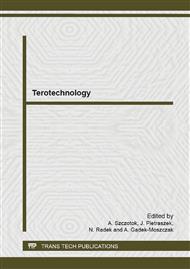[1]
D.C. Montgomery, Introduction to Statistical Quality Control, John Wiley & Sons, Inc., Hoboken (1997).
Google Scholar
[2]
M.S. Phadke, Quality Engineering Using Robust Design, Prentice Hall International, Inc., London (1989).
Google Scholar
[3]
J. McElroy, Taguchi - Japans Secret Weapon, 164 (1984) 18.
Google Scholar
[4]
D.C. Montgomery, Design and Analysis of Experiments, John Wiley & Sons, Inc., Hoboken (2008).
Google Scholar
[5]
G.E.P. Box, N.R. Draper, Empirical Model-Building and Response Surface, John Wiley & Sons, Hoboken (1987).
Google Scholar
[6]
R.H. Myers, D.C. Montgomery, Response Surface Methodology. Process and Product Optimization Using Designed Experiments, John Wiley & Sons, Hoboken (1995).
Google Scholar
[7]
J. Pietraszek, Response surface methodology at irregular grids based on Voronoi scheme with neural network approximator, Adv. Soft Comp. (2003) 250-255.
DOI: 10.1007/978-3-7908-1902-1_35
Google Scholar
[8]
T.P. Ryan, Modern Experimental Design, John Wiley & Sons, Inc., Hoboken (2007).
Google Scholar
[9]
O. Kempthorne, K. Hinkelmann, Design and Analysis of Experiments. Vol. 1. Introduction to experimental design, John Wiley & Sons, Inc., Hoboken (1994).
Google Scholar
[10]
I.T. Jolliffe, Principal Component Analysis, Springer, New York (2002).
Google Scholar
[11]
E. Skrzypczak-Pietraszek, J. Pietraszek, Chemical profile and seasonal variation of phenolic acid content in bastard balm (Melittis melissophyllum L., Lamiaceae), J. Pharmaceut. Biomed. 66 (2012) 154-161.
DOI: 10.1016/j.jpba.2012.03.037
Google Scholar
[12]
P. Osocha, P. Duda, B. Weglowski, Determining temperature and stress changes in thick-walled elements of steam lines, Inz. Chem. Procesowa 25 (2004) 2249-2256.
Google Scholar
[13]
B. Weglowski, P. Osocha, Modelling of Creep for Y Pipe from Ferritic-Martensitic P91 Steel, Rynek Energii 6 (2009) 140-145.
Google Scholar
[14]
P. Duda, Solution of multidimensional inverse heat conduction problem, Heat Mass Transfer 40 (2003) 115-122.
DOI: 10.1007/s00231-003-0426-z
Google Scholar
[15]
D. Gorissen, I. Couckuyt, P. Demeester, T. Dhaene, K. Crombecq, A Surrogate Modeling and Adaptive Sampling Toolbox for Computer Based Design, J. Mach. Learn Res. 11 (2010) 2051-(2055).
Google Scholar
[16]
A. Gądek, S. Kuciel, L. Wojnar, W. Dziadur, Application of computer-aided analysis of an image for assessment of reinforced polymers structures, Polimery-W 51 (2006) 206-211.
DOI: 10.14314/polimery.2006.206
Google Scholar
[17]
A. Gądek-Moszczak, L. Wojnar, Objective, Quantitative and Automatic X-Ray Image. Analysis of the Bone Regenerate in the Ilizarov Method, ECS10 The 10th European Congress of Stereology and Image Analysis (2009) 453-458.
Google Scholar
[18]
A. Gądek-Moszczak, S. Żmudka, Description of 3D microstructure of the composites with polypropylene (PP) matrix and Tuf particles fillers, Solid State Phenom. 197 (2013) 186-191.
DOI: 10.4028/www.scientific.net/ssp.197.186
Google Scholar
[19]
N. Radek, B. Antoszewski, The influence of laser treatment on the properties of electro-spark deposited coatings, Kovove Mater. 47 (2009) (1) 31-38.
Google Scholar
[20]
N. Radek, E. Wajs, M. Luchka, The WC-Co electrospark alloying coatings modified by laser treatment, Powder Metall. Met. C+ 47 (2008) 197-201.
DOI: 10.1007/s11106-008-9005-7
Google Scholar
[21]
P. Mazurek, Optimization of Memory Accesses for CUDA Architecture and Image Warping Algorithms, Adv. Intell. Syst. 184 (2013) 127-134.
DOI: 10.1007/978-3-642-32384-3_16
Google Scholar
[22]
Minitab v. 16, Mintab, Inc. (2012).
Google Scholar
[23]
S.S. Stevens, On the theory of scales of measurements, Science 103 (1946) 677-680.
Google Scholar


